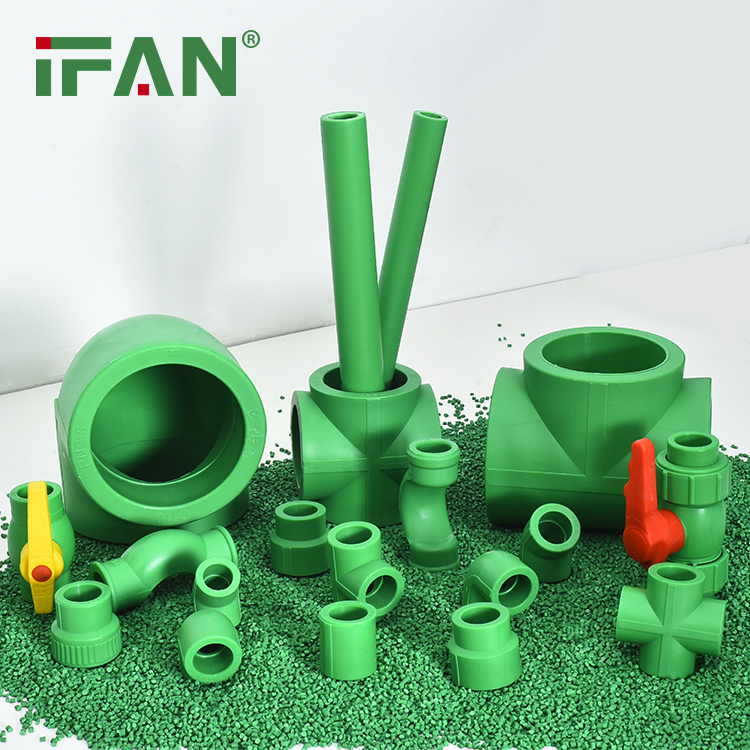What Fittings Connect PPR Piping?
Reviewing Attachment Options
PPR stands for polypropylene random copolymer, which refers to a type of flexible plastic piping used for heated water delivery and cooling lines in residential and commercial buildings. PPR pipe fittings attach tubing sections to create complete pressurized flow networks. Choosing connector styles suiting PPR properties and construction goals enables successful system performance.IFAN factory with 30+ years of manufacturing experience supports color/size customization and free samples. Welcome to consult for catalog and free samples. This is our Facebook Website: www.facebook.com.

PPR Fitting Defined
PPR fittings are connectors used to join pipes, change direction, branch off, alter sizes, and adapt to other components in PPR piping systems. Fittings create secure, watertight PPR joints able to withstand pressure fluctuations and movement.
PPR fittings are manufactured from the same thermoplastic material as the pipes to ensure reliable connections. They come in a wide variety of configurations to accommodate different piping layout requirements.
Common PPR Fitting Types
PPR fittings come in many standard shapes and functions:
- Elbows – Turn 90 or 45-degree angles in piping runs.
- Tees and crosses – Allow branching main lines to feed fixtures and equipment.
- Couplings and unions – Join two sections of straight pipe.
- Adapters – Connect to pipes of other materials like copper or galvanized steel.
- Caps – Close off the end of a pipe.
- Reducers – Transition between different pipe sizes.
- Valves – Control water flow and provide isolation points.
This range of fitting shapes allows for assembling complete piping networks from supply manifolds to final outlets.
Key Properties of PPR Pipe Fittings
Quality PPR fittings possess the same beneficial attributes as PPR pipes:
- High strength – Ability to withstand pressure surges without leakage or breakage.
- Corrosion resistance – PPR fittings are inert to water exposure.
- Thermal endurance – Performance retained through temperature extremes.
- Flame resistance – PPR is self-extinguishing and won’t fuel fires.
- Flexibility – PPR fittings move with pipes as they expand and contract.
NSF certifies PPR fittings for contact with potable water. The neutral material does not impart tastes, odors, or contaminants to flowing water.
PPR Cold Press vs. Threaded Fittings
PPR fittings connect to PPR pipes through an innovative cold press method rather than using threads. The fitting contains an internal O-ring gasket that gets compressed around the inserted pipe via a pressing tool.
This forms a strong, permanent seal able to withstand years of pressure and temperature fluctuations without leaking. Pressed PPR joints simplify and speed up piping installations compared to threading and cementing pipes.
PPR Transition Fittings Connect Dissimilar Materials
While PPR plumbing systems utilize PPR fittings for most connections, adapters are needed to integrate components made of other materials:
- PPR x copper adapters
- PPR x galvanized steel nipples
- PPR x PVC/CPVC couplings
- PPR x female threaded valves, pumps, or equipment
Having suitable transition fittings prevents limiting PPR to only certain sections of plumbing and expands integration capabilities.
PPR Pipe Fittings Proper Support and Installation
PPR fittings systems require proper installation to fulfill performance expectations:
- Pipe ends cut squarely with all burrs removed
- Fitting socket and O-ring completely clean
- Pipe marked at proper insertion depth
- The pipe fully inserted into the fitting socket
- Approved press tools used to completely compress the fitting
- Pressure testing conducted to validate joint integrity
Following specifications ensures optimal PPR fitting function and tight sealing for decades of reliable service life.
The Essential Role of PPR Fittings
From connecting straight pipe runs to adapting water outlets, PPR fittings serve indispensable functions enabling high-performance piping networks. Their ability to join pipes, direct flow, and integrate components is essential to realize PPR’s full potential over traditional piping.
As PPR expands globally across critical systems, quality PPR fittings provide the connections that bring improved plumbing capabilities to life.
IFAN
IFAN factory started in 1993. And IFAN has a workshop of 120000 square meters with 610 staff. IFAN can design and produce all plumbing pipe and fitting including PPR, PVC, CPVC PPSU HDPE PEXA PEXB PERT pipe and fitting, brass fitting, brass ball valve, heating system, gas system, sanitary faucets, and hose, In the past 30 years, IFAN has never forgotten his mission-To protect health and safety. The IFAN factory uses the best materials to produce high-quality pipe and fittings with an automatic production line and high-tech quality control machines.

